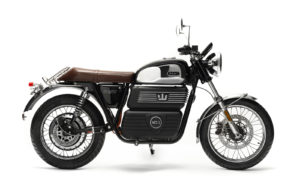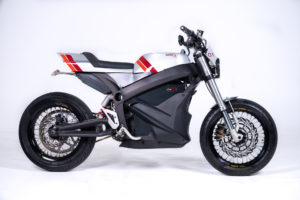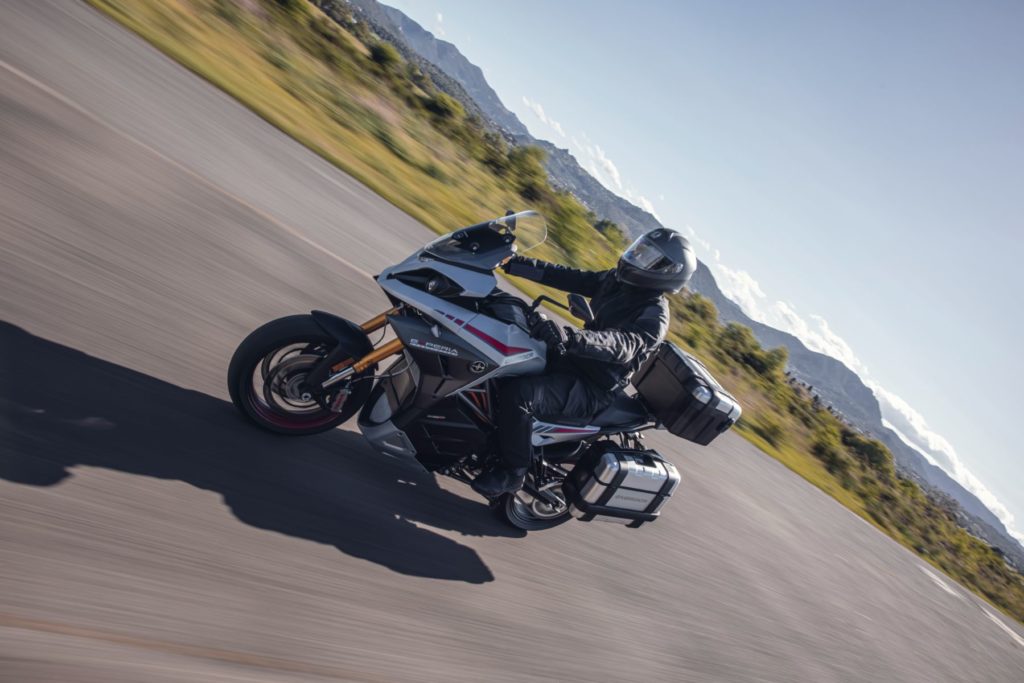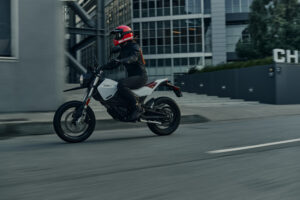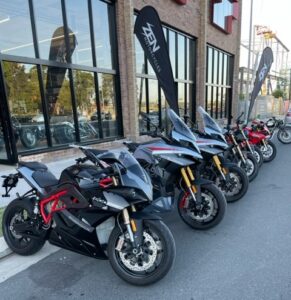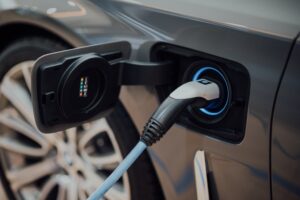Ready to make the switch to electric motorcycles? Here are the 5 biggest things you will notice when buying an electric motorcycle.
When you make the switch from riding a gas-powered motorcycle to electric motorcycles, there are some changes you will have to be ready for.
If you’ve already had the chance to test ride an electric motorbike you kind of know what we’re talking about, it’s a completely new riding experience. It’s also a completely new ownership experience. You’re going to have to unlearn many of the habits you’ve formed over the years, which at first might sound a little unnerving, but keep reading and you’ll see a lot of these changes will make owning a motorcycle much easier.
1. Say goodbye to classic Motorcycle Aesthetics
Before we get into the habit stuff we need to address one of the biggest gripes many riders have with electric motorcycles – Design. What we love most about classic motorcycles is how an exposed engine and mechanics complete the aesthetic. Everything is naked and on show, and that’s how it’s been since my granddad was riding. However, with upgraded electric drivetrain technology, a lot of the pieces that complete the look of the bike aren’t needed. Strip away the piston engine, gearbox, air filters, carburettors, exhaust, tank etc. and you’ve taken half of the bike’s character away!
Some Electric manufacturers have done their best to design motorcycles that appeal to the aesthetic of classic motorcycle lovers, take the RGNT No.1 Classic or Scrambler for example. Or any of the Live Wire by Harley Davidson projects. You’ll notice this less on sport bikes, like the Energica Ego or Eva Ribelle. But in general, most electric motorcycles are missing some of that classic custom motorcycle feeling. GRID Cycles is one company looking to bring classic looks to modern electric motorcycles. Not everyone wants to look like they’re riding something out of Star Trek.
Here are some examples of electric motorcycles styled for traditional design.
2. Get ready for Insane Performance
If torque, speed and instant power are what matters most for you, then an internal combustion engine (ICE) won’t cut it for long once you test ride a premium electric motorcycle. An ICE doesn’t run much below its idle speed of 1000rpm with torque building to a maximum several thousand RPM later. Electric motors reach peak power and torque almost instantly from 0 RPM, they also maintain linear power throughout the RPM range. A top of the range Energica will take you from 0-100 km/h in as little as 2.6 seconds – and a couple of seconds later you’ll hit 200 km/h. The traction control will stop you lifting the front wheel, but it won’t save your license.
Another performance quirk to consider with electric bikes vs petrol, you get more range out of slow, stop/start city riding than highway riding. Counter to what you would expect with a petrol bike – electric motorcycles love braking which can send power back into the battery through regeneration. Long, open highways ridden at high speed give little chance for regenerative braking and the constant stress on the battery and controller mean range shortens much quicker. As a rough guide – whatever you see on the manufacturer’s expected city range – halve this for highway riding. That means the 21.5 kWh Energica models can do 400 kms city range and 200 km highway range.
3. No more fuel stations – plug in
Switching to electric vehicles means no more trips to the fuel pump. How about having a gas station in your house? And no more waiting in line at service stations during rush hour! Even if you are in need of a public recharging station, Australia has been investing heavily in charging station infrastructure with more being built all the time. In the Gold Coast which we call home – we’ve never seen a queue for public electric vehicle chargers.
If you start building a habit of charging your electric motorcycle when you’re at home, or while you’re at work, you will never have to worry about stopping at a charging station again! If your bike has DC fast charging available like Energica’s Ego, Ribelle, EsseEsse9 and Experia – then you can usually expect to charge your bike to 80-90% in under an hour.
There is a bit to learn when it comes to charging technology, there can be 2-3 different charging options available for most motorcycles and a range of charging cables depending on the bike you own. There has been a big effort to standardize charging cables across the world, and it’s been pretty successful so far – CCS seems to be the EV plug to rule them all going forwards. For more information on charging check out these other articles we’ve written.
3. Lower maintenance and Ongoing Costs
Yes, high performance electric motorcycles are more expensive to buy than gas motorcycles – they are still a premium product in a new, evolving market. After the purchase price however, that’s where the big costs usually stop and you can save a bunch of cash. Maintenance is pretty low on electric bikes – the Energica Ego+ for example requires a basic service at 1000 kms then the next service is due at 40,000 kms
Compare that to a new Ducati Panigale which requires multiple services before 10,000 kms and an extensive Demso service at 24,000 kms for which you’ll be shelling out a couple of thousand dollars. And if you can charge at home or work, you’ll end up paying just a couple of bucks in electricity per tank of charge – compared to $20 on a standard petrol motorcycle. That can add up quickly if you’re smashing out the kms on commuting or regular rides. Check out the electric vs fuel calculator on our website and our blog on how to charge your electric motorcycle using just solar power.
What’s surprising for many riders is – once you factor in resale value for premium electric motorcycles, your annual cost of owning one of those bikes is actually lower than a lot of new petrol motorcycles. At AEMC we bought a 2015 Zero SR for $28,000 new. That bike is 7 years old and still worth $15,000. Fuel costs have been very low – but let’s be generous and say we spent $1,000 on electricity in those 7 years. Servicing has been almost non-existent, we’ve spent way less than $1,000 on maintenance (a new belt drive and brake pads) in that time. We’ll exclude stamp duty and rego costs because they vary by State but in QLD we pay the lowest amount because EVs are cheaper than petrol vehicles. So that’s an annual cost of around $2,150. In 2018 we bought a new Ducati Scrambler Icon for $17,000. Servicing on that bike cost $3,000 over 3 years. Fuel cost around $2,500 for 3 years of commuting. We sold the bike for $11,000 in 2021. That bike cost $3,800 per year to own excluding rego/stamp duty. That’s almost double!
4. More ways to monitor your motorcycle and riding
Connecting your smartphone to your motorcycle is pretty much standard these days. Most manufacturers offer smartphone integrations that communicate with your device that allow you to monitor things like…
- The bikes GPS location (handy for parking)
- The bikes charge
- Nearest charging stations
- Motorcycle diagnostics
- Performance control
- Ride data (location, power, energy, torque etc)
- Horn control
- Dash control
Each brand offers something different in their apps. This is the future of riding.
5. A more comfortable ride
By nature electric motorcycles are much quieter than gas bikes – this can be a good thing or a bad thing considering your preferences. For some riders, there’s nothing they love more than the rumble of an engine or the satisfaction of a bike screaming past them. Electric motorcycles are much easier on the ears. Which means you start to notice a lot of other sights and sounds.
Electric bikes also don’t vibrate like gas bikes, no more shaking at red lights. And while some IC bikes do offer counter-balances to reduce vibrations, this adds another layer of mechanical complexity to the bike, meaning one more thing that can go wrong and needs fixing.
The two final points we’ll make on comfort is firstly, no more burning yourself on exhaust headers and secondly, no more clutch or gears to worry about. This last point makes riding in urban settings a lot more comfortable, no shifting gears every few seconds in commuter traffic.
That’s not to say that all electric bike manufacturers do away with the clutch and gears completely. Energica have internalized the gearing into the motor so you’ll still hear it, you just won’t need to operate it.
If you still have if, buts or maybe’s after reading this article then there’s only one thing left to do. Book yourself in for a test ride and see the difference for yourself. Or comment your questions below and we will answer what we can.
We are stoked to be able to offer you the chance to upgrade to an electric bike and we know you’re going to enjoy making the switch. We’ll admit, you are going to have to get ready to make some changes. But this is the future of riding, and we’re here to bring it to you!

